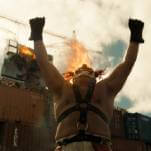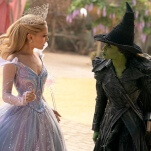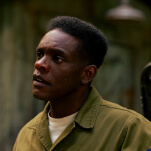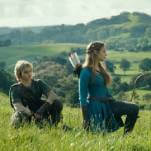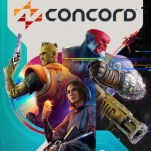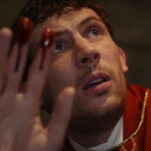In an attempt to backdoor a funny-animal revival during an era when superheroes were dominating comics, cartoonist Scott Shaw and writer Roy Thomas came up with the bright idea to combine the two genres in the series Captain Carrot And The Amazing Zoo Crew, which debuted in 1982 to moderate success. Shaw's gag-packed art—as well as his clever re-imagining of DC heroes in animal form—was the main selling point for Captain Carrot early on, and was the selling point again when DC revived the concept for a 2007 miniseries. Its Captain Carrot And The Final Ark trade paperback collects that miniseries plus a few issues from the early-'80s run, and it's all delightful to look at, but a strain to read. No matter the era, Captain Carrot comics tend toward the cramped and convoluted, with plots that are subservient to the jokes. And no matter how well-observed or snappily rendered, jokes about the conventions of superherodom have a limited shelf life… B-
On the other hand, the career of Fred Hembeck proves that jokes about the culture of comics itself can be funny and sweet. The Nearly Complete Essential Hembeck Archives Omnibus (Image) collects nearly a thousand pages of Hembeck short stories, one-pagers, sketches, and spot illustrations, written and drawn over the past three decades. Though the book is missing the gag strips Hembeck has done for Marvel and D.C. over the years, characters from both publishers are well-represented—as are Archie, Flash Gordon, and dozens of other iconic and obscure heroes. An unapologetic fanboy, Hembeck revels in recreating old covers and stories, then populating them with his butt-headed, google-eyed, swirl-kneed renditions of comics legends. The result isn't so much satire as homage, though Hembeck does poke fun at his own delusions of grandeur and his lifelong obsessions with TV and superheroes. The Hembeck Archives records a life spent as a happy geek… B+
Johnny Ryan is like a Hembeck for the alt-comics set, but with more perversion and fecal matter. Ryan's latest collection, The Klassic Komix Klub (Buenaventura) follows up on the irreverent, ferociously scatological Comic Book Holocaust, in which Ryan sent well-known comics characters careening through a world of spontaneous sexual violation and golden showers. This time out, Ryan has a go at the classics of world literature, but to be honest, while it's still pretty funny to see, say, Hercule Poirot insert his umbrella into a suspect's penis and then open it, Ryan's shock comedy has lost some of its shock. That's the burden of humorists who work on the extreme end of the spectrum: after a while, their unchecked ids cease to be refreshing and start to get a little boring… C
When Dark Horse obtained the comics rights to Robert E. Howard's Conan character in 2003, the company brought in a writer with a grand plan, Kurt Busiek (Astro City), to run the show. Said plan was to proceed through Conan's history chronologically, adapting Howard's stories and filling in the gaps with original material. Busiek left for DC a few years later, but first, he finished the issues collected in Conan: Born On The Battlefield. Working with artist Greg Ruth, Busiek provides the barbarian with a bloody, melancholy origin story, from his ominous birth to the exile from the homeland he could never really call home. Both writer and artist bring a brutal lyricism that brings it to the front ranks of Conan stories in any medium… A-
An athlete from the future seeking to get rich in the past (with some help from a flying robot named Skeets), Booster Gold has never, by design, been a top-rank superhero. Creator Dan Jurgens must have realized that the losers were more fun to write, and others have kept the tradition alive. The first issues of Booster's latest series get collected in Booster Gold: 52 Pick-Up (DC). Co-written by Geoff Johns and Jeff Katz with art by Jurgens, it finds Booster traveling through time, partly in a quest to revive his late friend, Blue Beetle. The team has a lot of fun with the comic possibilities of time travel, but there's real heart to it as well. The series has quietly become one of the most satisfying superhero comics out there right now… B+
Frank Miller and Jim Lee's All-Star Batman And Robin The Boy Wonder debuted to noisy fanfare and an almost equally noisy backlash, losing its record-breaking readership as the gap between each divisively received issue became greater and greater. It's a uniquely frustrating comic, but one that has its own considerable rewards when read in bulk in the hardcover collection of its first nine issues. Miller helped redefine Batman as brilliant, terrifying force for justice in the 1980s with The Dark Knight Returns and Batman: Year One, then took the character to cartoonish extremes years later with The Dark Knight Strikes Again. In All-Star Batman, his writing at first seems to be suffering from a creative hangover from that last project: This Batman is borderline demented, more a refugee from the apocalyptic world of Strikes Again than a precursor to it. The story focuses on Batman's adoption of Robin, essentially recast as an elaborate child abuse. But if you can get past: a) an issue in which a character flips out over men leering at her, in the middle of a book in which the art even finds a way to sexualize a woman wearing a hospital gown; b) willfully obnoxious dialogue that reads like a parody of the gritty comics that Miller's '80s work inspired; c) Wonder Woman calling men "sperm banks"; d) a central story that's uncomfortably exploitative of a main character's grief and apparently nowhere near done in spite of the delays, it's actually weirdly thrilling. Miller's Batman plays by none of the expected rules, and with Lee, Miller opens familiar DC characters to all kinds of perverse variations that raise the question of how these characters became heroes in the first place. Watching Miller put his personal spin on icons is both the best and most frustrating thing about the book… B
For another unusual look at Batman, check out Yoshinori Natsume's manga miniseries Batman: Death Mask (DC), now halfway through its four-issue run, and still focusing more on Bruce Wayne than his alter ego; Natsume digs into Bruce's teen years training as a martial artist, and finds connections between Japanese myth and the Batman mythos, having to do with a mystical mask. There are a few weird decisions in the art—when a killer is going around slicing people's faces off, it's a problem when the artist renders people's heads as solid, uniform matter all the way through—but overall, Death Mask is shaping up as a solid sideways exploration of the meanings behind masks and the bat-mask in particular, from concealment to re-creation… B
Meanwhile, Grant Morrison's run on Batman continues to put his own spin on the Dark Knight over in the DC Universe proper. "Batman R.I.P." is the latest storyline, and so far, we've seen the introduction of a powerful, Batman-hating cabal, and the possibility that Batman might be insane as well as possibly death-bound. It's gripping stuff. Here's hoping it doesn't end in a gimmick… B+
Elsewhere, Gail Simone's run on Wonder Woman continues to find fresh material for an often-mishandled character. We'll no doubt take a more in-depth look at it later when it starts to hit trades, but fans of monthly superheroics should certainly to check it out, if only for a look at previously unseen Amazonian courting rituals… Volume two of Simone's Welcome To Tranquility (Wildstorm) reads a lot like volume one, with a ton of mini superhero origin stories and interactions wedged into a crowded overplot in which zombies attack a sleepy mostly-superhero community and a minion of hell tries to take over. It takes up almost exactly where volume one left off, too. So it's a bit of a wonder that a series that's only just finding its feet can already mine such rich territory by bringing back characters who were presumed lost, and digging a little deeper into characters previously relegated to the background. Simone's Alan Moore influences are pretty bald, from the Top 10 flavor of her superhero city to the way she contrasts old four-color comics and vintage ephemera starring her heroes with the "real life" versions of them in the "present"; it all feels familiar, but it's still executed with style and love, and until Moore puts out more Top 10, something's gotta fill the void… Wonder Woman: B; Tranquility: B+
Joe Kubert has been drawing comics since the 1940s. Now 81, he's gotten pretty good at it. The new Tor (DC) miniseries revives a prehistoric adventurer Kubert first breathed life into back in 1953. Two issues in, the story seems a bit familiar, but Kubert's art and flair for visual storytelling remains as strong as ever… B+
Writer Greg Pak made the Hulk into an interplanetary gladiator and rebel leader with Planet Hulk, essentially dropping the Marvel monster into a smartly reconfigured Edgar Rice Burroughs story. With the new series Skaar, Son Of Hulk, he revisits that world, following the offspring Hulk doesn't even know about as he fights his enemies. And fights and fights. The first issue is pretty much nothing but otherworldly combat with little insight into who Skaar is. For what it is, it's kind of exciting, thanks especially to Ron Garney's art, but with no added depth, this could get old quickly. Then again, Planet Hulk took a while to get started, so it might be worth sticking around… B-
For some reason, we stopped getting review copies of Dark Horse graphic novels for a few months. That's been remedied, but it left us with a backlog, and we're playing catch-up. Here are a few of the things we missed in the interim: Adam Warren's Empowered Volume 3 continues the softcore saga of a hapless superheroine whose symbiotic alien super-suit is easily torn, and who regularly winds up bound, gagged, and lamenting her weaknesses. It's always two steps forward, one step back with Empowered; this volume pushes the plot development with more background and more story from Empowered's boyfriend Thugboy, her best friend Ninjette, and even that alien suit itself, but it largely relegates Empowered herself to lengthy bondage routines that don't go anywhere new. Granted, that's the bread and butter of the series, and granted, there are only so many ways to tie up a nearly naked woman, but it feels like Warren has hit most of them at this point. Still, the series remains fun both for the obvious fetish and in spite of it… Rick Remender's Fear Agent also hits volume three with The Last Goodbye, a collection that changes the tone considerably. What was a wacky, grim-'n'-gritty space adventure that felt like something out of early Heavy Metal flashes back to the hero's once-idyllic home life and shows the ugly birth pangs that made him and his erstwhile wife what they are in the series' present. It's manic and messy, and has a lot in common with standard zombie stories, right down to the gore, lovingly detailed by Tony Moore. It's also an excellent jumping-in point for the series, especially given that it finds the humanity in its protagonist, who was previously hiding behind the drunken-asshole shell of a seriously damaged man… The Mother Of Mountains, the latest volume in Stan Sakai's ongoing non-funny funny-animals-in-Japan series Usagi Yojimbo, isn't the best jumping-in point for newbies, but it's better than most, since it confines its action to a relatively small area and re-establishes the few main characters involved. In this case, Usagi (the series' rabbit ronin protagonist) and his old friend Tomoe wind up investigating reports of plague, and instead running across a secret mining project run by an old foe of Tomoe's. As always with Usagi Yojimbo, the book is a masterful example of well-paced storytelling, period Japan detail, drama, and humor, and Sakai goes further than usual here in showing Usagi's weaknesses… Finally, the latest addition to Dark Horse's Neil Gaiman Library is The Facts In The Case Of The Departure Of Miss Finch, a fillip of a story reminiscent of Stephen King's "Mrs. Todd's Shortcut." Artist Michael Zulli gives its dreamy but un-idealized circus performers the royal treatment, and makes his protagonists hyper-real, which helps ground the fantasy story, but it's all a little straight-ahead, without any particular narrative surprises. This one's more about striking visuals than rich storytelling… Empowered: B-; The Last Goodbye: B; The Mother Of Mountains: A-; Miss Finch: C+
Jamie McKelvie's collected Suburban Glamour (Image) starts out strong, with a closely observed look at bored high-schooler Astrid Johnson and her friends as they try to find some fun in their dull lives in a suburban town. Then it turns into a literal fairy story, but that story feels curtailed and far less nuanced. Astrid's imaginary friends, who return from her childhood once magic re-enters her life, stand as symbols for what's wrong with the story: They never really get characters of their own, and they never really do anything but stand around and say "Hi, we're your imaginary friends from childhood, come back because magic has re-entered your life." It's a Charles De Lint story with no bite and no depth. At least McKelvie's crisp, flat art looks good… Hitting a few similar notes but pouring on the depth from page one, Vertigo's new series launch Madame Xanadu takes on Arthurian legend from a fairy-tale angle, starting with Nimue out in the forest as an antlered fae creature surrounded by chanting sprites, and trying to decide what to do with the terrible portents she's seeing, likely related to her sister Morgana. Some familiarity with Arthurian legend helps made sense of the dialogue-packed first issue, as writer Matt Wagner jumps in with both feet and hits the ground running off at the mouth, but the fast pace and the no-time-for-tyros attitude are both instantly immersive, as is Amy Reeder Hadley's finely detailed, complicated art, which is almost shockingly pretty… Suburban Glamour: C-; Madame Xanadu: B+
As with Suburban Glamour, the ending is a problem for Ross Campbell's Water Baby, the most hardcore book from DC's Minx line to date. Previous Minx books have offered various teen-girl-aimed visions of the world, focusing on mysteries, romance, and relatively tame art rebellion, but Water Baby goes much further in creating its own unique world and its own unique character, and acknowledging that not all rebellion looks alike, or comes in safely prepackaged forms. The protagonist, a tough surfer girl named Brody, has her leg bitten off by a shark in the early pages of the book, but where most stories would revolve around how she adapts to being crippled and how she finds her feet again, Water Baby all but shrugs off the damage as just another of the many things that make one person different from another. Campbell plays ruthlessly with presumed reader assumptions, by sexualizing Brody heavily—she's prone to minimalist clothing and a profound lack of body modesty, and Campbell emphasizes her heavy breasts and tiny pert ass—and then emphasizing her stump, her love of farts, belches, and boogers, and her raw punkish aggressiveness, physically and emotionally. The only real sign of the issues plaguing her—the only way she reveals her inner weaknesses, and then only to the reader—is through ongoing surreal, horrifying nightmares about sharks. Water Baby eventually develops into a road story involving Brody's best friend and sleazy ex, and from there it becomes more than a little picaresque and wandering, but Campbell's offhanded, cliché-defying characterization make the whole journey into a trip worth taking. There are only two real disappointments: The erratic, inconsistent, and generally misguided way Campbell sometimes breaks up the story with cartoony word balloons, and the fact that the whole thing peters out at the end without really getting anywhere… A-
So get this: A clone of Jesus Christ fights vampires in a Church-dominated post-apocalyptic future. Ridiculous? Yeah. Trashy? Hell yeah. Dumb? Kinda. Loads of fun? That too. Tim Seeley's collected Loaded Bible (Image) puts some surprising complexity into its silly premise, and turns its faux-Christ into an admirably resonant figure. Sharp, stylish, somewhat cartoony art helps make the whole thing into a solid, thought-through package that belies the exploitation factor of the ridiculous theme and the frequently naked anti-hero vamp that keeps popping up to tempt our Lord and (nouveau) Savior… B
The first few issues of Mike Carey's Faker (Vertigo) were none too promising, but the completed series at least goes somewhere, albeit somewhere pretty weird and random. It reads a lot better in collected form, though those first issues still take too long to develop any particular sense of plot, and sympathy for the beleaguered protagonists never really does surface… By contrast, the final volume of Brian K. Vaughan's Y: The Last Man, Vol. 10: Whys And Wherefores (Vertigo), seems choppier and more random in trade form. With the actual whys and wherefores out of the way in previous issues, the remaining issues that counted down to the series end were breathless and filled with sudden shocks, surprises, and switchbacks, and while they were heartbreaking in single-issue form, spaced out over months, the story seems distracted and all over the place when read in close order. Still, there's no beating that final issue. Faker: C; Last Man: B+

